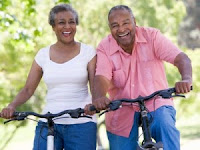Intermittent Thoughts on Intermittent Fasting - Programing Success: Stocktaking, Goal Setting, -Tracking & -Resetting to Achieve a Healthy Weight & Shed Excess Body Fat
 |
| Image 1: You need to know exactly where you are and where you want to go. Read on to learn how your very own PPS can help you in achieving the goal you set as a homework from the last episode. |
PPS - The Personal Positioning System
To assess "where" chubby or whatever you are coming from is, you cannot simply whip out your shiny iPhone and use the GPS map. What you will need is a PPS system, a "Personal Positioning System" that will not only tell you were you are, but - if programmed correctly (and this is what you will learn in this and the following episodes) - also where to go next in order to achieve another step towards your destination goal. Contrary to the GPS, where the reference points are the many base stations of the system, your unique reference point is you! This fact has one very important implication: Just as the accuracy of the real GPS system is limited by its knowledge of the exact position of the base stations and satellites (EU's Galileo system will provide a whole new dimension of exactness in this regard, being about 5x more accurate than the old GPS) the goal-directedness of your everyday efforts in the kitchen and the gym will depend on an unbiased accurate assessment of your starting point.
last installment (figure 2).
King Size Homer: Wait loss at all costs
Let's start with "King Size Homer", a victim of the sedentary Fast-Food Society. No matter what his dreams for the future may be and how much he may suffer from the way people react to the way he looks (Lewis. 2011), Homer's first and foremost concern must unquestionably be his health... interestingly, though, the latter will automatically improve with every pound of body fat King Size Homer is able to shed off his morbidly obese body. A 2002 study by Kopp et al., for example, showed that weight loss (unfortunately induced by a debilitating crutch that is known as "gastric surgery") alone led to significant reductions in circulating IL-6 and CRP and major improvements in insulin resistance. Now, those of you who read yesterday's news on the benefits of HIIT as a supplement to the already intense training regimen of 29 judo players, may remember my remark on how "classic cardio training" such as walking on an inclined treadmill turns into high intensity interval training for people like King Size Homer, after all, they are carrying a weight "normal" people would if they were doing a farmer's walk. It is thusly not surprising that regardless of the type of exercise, and even in the presence of "the crutch" (bariatric surgery, cf. Egberts. 2011), exercise has been shown time and again to promote weight loss above what fasting, medication and even surgery (all of which can become necessary in some really extreme scenarios) alone can achieve (Chaput. 2011). Moreover, and this is probably even more important, constant revision and adaptation of his exercise and nutrition regimen are going to be the decisive factors which will keep Homer from falling back into his morbidly obese state once he has cut his body weight in half and achieved an astral body like Peter Griffin, already has it.
King-Size Homer's PPS-Cheat-Sheet:
- Goal(s): Lose weight at all cost, your health demands it!
- Tracking: In your case each pound counts - a standard scale will suffice to track your progress
- Resetting: Achieve "normal obesity", BMI ~30kg/m² before resetting your goals
Family Guy, Peter Griffin: Feed the Muscle, Cut the fat
When King Size Homer arrives at the "just" obese "Peter Griffin"-stage, things will change. He will by now have at least a minimal amount of fitness and in view of the 100+lbs of fat he has lost, simply using the stairs instead of the elevator will no longer suffice as his high intensity exercise for the day. The traditional hours on the treadmill in the "magical", yet factually non-existent fat-burning zone, on the other hand, will at best make him lose equal amounts of muscle and fat mass and thusly set him (or the now "just" obese Homer) up for the imfamous YoYo-effect. And as if this was not already enough Peter will hit a weight loss plateau after about 1-2 months, anyways. By then, his body will have have succumbed to the chronic level of low grade stress and will no longer respond to further reductions in calorie intake and / or increases in training volume. Peter will lose faith, give up and... eat. He will end up fatter (not necessarily heavier) than before, will feel miserable and like the "biggest loser".
 |
| Figure 2: Changes in fitness, insulin levels (lower levels indicative of higher insulin sensitivity), carbohydrate and fatty acid oxidation after no more than 6 HIIT sprinting sessions on an electromagnetically braked cycle ergometer (data based on Whyte. 2010) |
 |
| Image 3: You eat nutrients not calories. Weight loss comes with a nutrient dense, not a calorie deficient diet. |
Peter Griffin's PPS-Cheat-Sheet:
- Goal(s): Lose fat, keep (or build) muscle
- Tracking: A simple measuring tape to measure your waist circumference and your training log, in which you will record the weights you are using on the (optional) weight training days
- Resetting: Get your waist down into the <36" inch zone before you even remotely consider dropping the loss of body fat as your primary goal; at the same time set out to increase weights or reps on your major moves (squats, bench, deadlift, pull-up) every 2nd week
Anorexic Dad, Stanley Smith: Skinny fat no more
 |
| Image 4: Already lean? Then forget about the scale! |
Probably due to the unreasonable and (if you asked me) utterly unsexy ideal of the "beautiful" female model, whose major features are skinniness and a severe lack of skeletal muscle tissue, this obsession not with how much, but rather with how little you weigh, is rampant within the community of female fitness junkies. Based on the misunderstanding that weight loss (at least for females) would equal improvements in body composition, thousands of women starve themselves into what Dr. Connelly often refers to as an "reduced obese state" (also read the study on the changes after starvation diet in the red box above) - and that despite the fact, that many were "too skinny" (remember skin = fat + thin dermis) to begin with.
 |
| Image 5: When you have achieved a "normal" degree of leanness, building a beautiful body has little to do with losing weight, it's all about modulating the ratio of lean to fat mass (photo originally shared on Facebook by Erika Rice). |
Gaining, not losing weight makes you sexy!
Toning up, ladies and gentlemen, is about building muscle and losing fat. Regardless of whether you want to look like a goddess or just "look good naked", the concept of overall body "weight" has no significance in this context. It is thusly only consistent to give away your scale to the "King Size Homers" in your neighborhood (or anybody you do not like ;-) and to rely on progress pictures, like the lady in image 5, who gained 9lbs and finally overcame the "skinny fat" physique that tricks so many women (and men) into believing that they got to lose weight to achieve the physique of their dreams.
For the "skinny fat" and anybody who wants to improve his physique beyond simply being lean, progress pictures are thusly a must. In that, it is yet not necessary and probably not even advisable to take daily pictures like the ones that made John Stone (watch his transformation video) world-famous (you will just stress yourself about how "slow" your body changes and
the increased cortisol certainly won't help with the progress). One picture each week, taken in underwear in the morning, standing
upright (no posing) on a specific spot in a room, where you can ensure that the lighting is
always the same, is enough to objectively track your progress.
Being fit and healthy, the Stanley Smiths out there will keep or reduce (depending on how lean they already are) their HIIT exercise and increase, split and periodize the resistance training component of their exercise regimen from two to (initially) three sessions per week, while keeping a constant eye on the volume - after all, you should always remember you are not in the gym to burn calories! While the other idiots may be, you are in the gym to achieve your goals and I assume none of you has set "burn 1,000,000kcal" as his long-term goal, right?Stanley Smith's PPS-Cheat-Sheet:
- Goal(s): Lose fat, build muscle
- Tracking: Weekly training pics (optional: a body-fat caliper) and your training log, in which you will record the weights you are using on the obligatory weight training days
- Resetting: Especially for the women the next long-term goal may be "hold what you achieved", for the men it is likely that the focus will shift from losing fat to building muscle
 |
| Image 6: Plastic models illustrating the different densities and consequent volume differences of fat and muscle tissue (img from onemorebite-weightloss.com) |
Ah, and before you ask. As a physicist I can tell you that the body-impedance scales you can buy at every turn, which claim to give you exact numbers on your body-fat and body-water content, are about as exact as the weather forecast for the next week. They may be able to give an account of general trends, but the "exact" numbers they display are pretty random.
(Now) I am (already) lean - what do I do?
With all this thinking about goal setting, -tracking and -resetting for "healthy weight loss" and the first steps on the long way to an astral body, the time flew by so fast that I did not even have the chance to address the excellent "homeworks" Jahed, Pablo, RF and Angimal submitted in response to the last installment of the Intermittent Thoughts. I will make good for that in the next installment, when we will discuss goal setting, -tracking and -resetting for those who are already past the Stanley Smith state (anorexic or not ;-) and finally want to add some serious muscle to their now ripped, yet still undermuscled physique.




